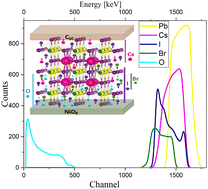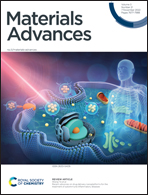Experimental evidence of ion migration in aged inorganic perovskite solar cells using non-destructive RBS depth profiling†
Abstract
Hybrid halide perovskites have made breakthroughs in a range of optoelectronic devices due to their favorable properties. Perovskites show mixed ionic electronic conductivity, which leads to current–voltage transients at timescales of milliseconds to hours and is responsible for hysteresis in the devices. Under the device-operating conditions, ions present in the bulk of the perovskites migrate towards the electrodes due to electrostatic effects, react with the interfacial layers and, thus, deteriorate the device performance and stability. Most experimental techniques used for probing ion migration in perovskites are indirect or destructive. In this work, we use Rutherford back scattering (RBS), which is a non-destructive technique, to investigate the elemental composition profile and interface diffusion between various layers to disentangle the extrinsic and intrinsic ion migration in inorganic halide perovskites (IHPs, e.g., CsPbI2Br). The experimental results suggest that I− ions are the most mobile and diffuse into adjacent layers in the CsPbI2Br-based inverted perovskite solar cells, followed by Cs+ ions. We also show that oxygen leads to intrinsic and extrinsic ion migration and that ion migration takes place in aged devices even in the absence of external stress.

- This article is part of the themed collection: Popular Advances


 Please wait while we load your content...
Please wait while we load your content...